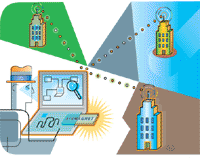Site Surveys Critical In Deployment Of WLANs
Add all of those problems to an enterprise environment, and solution providers can witness a Wi-Fi deployment spin out of control and installation profits dwindle. One answer to those problems comes in the form of Surveyor; a $1,995.00 wireless survey tool from AirMagnet, Sunnyvale, Calif.
Surveyor combines software with a specialized 802.11A/B/G PC card to troubleshoot wireless LANs using a slick graphical interface. In other words, technicians can now "see" exactly what is going on in a wireless network.

\
AirMagnet's Surveyor enables solution providers to offer effective wireless surveys at a lower cost.
There is no argument that a WLAN site survey should be the first step to successfully deploying a wireless infrastructure, but solution providers have to consider the costs involved. Some businesses are looking to cut costs in any way possible, often forgoing the site survey, which impacts a solution provider's bottom line and opens the door to problems with a wireless infrastructure. Surveyor helps to significantly speed the process, which allows solution providers to offer the survey at a lower cost to their customers.
Solution providers will find that Surveyor lives up to its name,the product is clearly geared toward collecting and analyzing WLAN site radio frequencies (RFs) for creating effective, easy to understand wireless surveys.
Launching the product on a notebook computer brings up the primary survey tool, which can import an image of the subject site's floor plan to build a graphical representation of wireless coverage for an existing or proposed WLAN deployment.
Surveyor offers two WLAN survey modes:
passive mode and active mode. Passive mode gathers comprehensive site RF data such as signal strength, channel allocation, noise level, signal-to-noise ratio, coverage, media type, transmission speed, packet loss/retry rate and other performance parameters. In active mode, the system can associate with a specific AP or SSID to fine-tune performance measurement, a handy feature when there is overlap between multiple WLANs.
That dual functionality continues with the product's ability to present data in two different display modes: by channel or SSID. This allows technicians to better define signal overlap and detect WLAN boundaries, an important capability when deploying enterprise-level WLAN infrastructures. Other key features include the ability to run WLAN simulations, which enables technicians to perform "what-if" scenarios before
relocating access points. That feature alone could save several hours of deployment time.
For existing WLANs, the included diagnostic tools can analyze signal distribution patterns and conduct end-to-end connectivity tests with DHCP and Ping at any time.

Surveyor's interface is intuitive, and the context-sensitive help answers any questions one might have. Getting started with a survey is a simple matter of laying out the dimensions of the site and then importing an image of the floor plan.
Once the floor plan and dimensions of the subject site are entered, technicians can set up a survey path. In other words, the technician roams the site while Surveyor, running in passive mode, detects WLAN signals. That process helps to locate dead zones and RF interface issues, while creating accurate signal maps. Solution providers can create complex reports or proposals from the graphical representations offered by Surveyor.
All things considered, AirMagnet's Surveyor has the goods to successfully pull off a WLAN site survey, without putting undue requirements on solution providers or their customers.